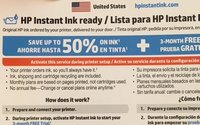Commentary
Connected Home Objects Link Brands Directly To Consumers; A Handoff From Retailers
- by Chuck Martin , Staff Writer, May 15, 2016

And in the process, some retailers may find themselves being somewhat cut out of the picture.
It’s not necessarily that consumers themselves are making the initial move, since some new, direct-connect capabilities are being built in to things that people buy.
In one of my recurring visits to Staples to buy a print cartridge over the weekend, I made my normal check to see whether it was more cost effective to buy a replacement cartridge for my current HP printer or to buy a new printer.
This has been my printer-purchasing model for many years, finding that with periodic printer sales at retail, it’s sometimes less expensive to buy a new printer than replacement cartridges for the old one.
The dilemma, of course, is that with multiple ink cartridges in a printer, generally it’s only one that has run out, making the overall economic equation challenging.
The Internet of Things is changing that.
Printers are coming equipped with ink self-monitoring sensors, so that a printer can tell when a cartridge is running low, triggering an automatic reorder from the manufacturer, the brand, rather than from the retailer.
At my Staples visit this weekend, I grabbed a $40 black cartridge, scanned it to see I could get it for $38, thanks to competitive price matching, and headed to the printer section to check the deals of the day before checking out.
At this visit, there happened to be an HP rep who asked if I was looking for a new printer. She suggested I look into getting an Instant Ink ready printer, essentially an Internet-connected printer that tracks its own ink and auto-orders.
As editor of the IoT Daily and writing a book on this, how could I not buy that?
I bought the printer, set it up and signed up for automatic ink tracking and ordering, directly from HP. My printing relationship is now with HP, not Staples.
Even if the retailer receives recurring revenue as a percentage of ink sales from the brand, the consumer relationship is handed off.
Since HP will know precisely how many pages I’ll be printing, it’s not a big leap to have them suggest that I buy my printing paper from them, which could easily be delivered along with the ink cartridges, which will be sent before any current cartridge runs dry.
And this example is only regarding printers.
Appliances bought at retailers like Best Buy and Sears will have similar tracking and supply ordering technology built in.
The embedded technology phenomenon is creating new and direct conduits for brands to consumers.
For me, this means fewer trips to Staples to get replacement cartridges, along with all the other things I always ended up buying while at the store.
For millions of consumers, who may not realize they have joined the IoT revolution, a new world of communication with their brands is about to open.



